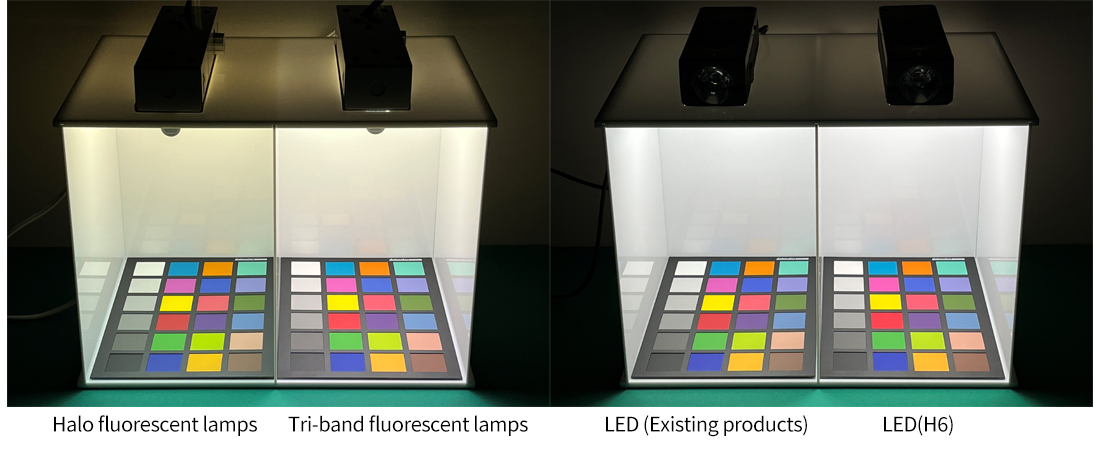 History of Light Sources - Color Rendering Index (CRI)
History of Light Sources - Color Rendering Index (CRI)
10 January 2024
The History of General Lighting and CRI
In the lighting industry, the characteristics and advantages of light sources are typically discussed in terms of luminous flux and/or efficacy; however, CRI, chromaticity, and spectral distributions are also important factors of light. Among these, CRI is a very important characteristic that determines how close an illuminated object looks to what it would like under natural light. In this blog, Nichia has chosen to focus on CRI and its history as the main theme and this first blog post will discuss the importance of general lighting, which is indispensable in our daily lives.
The history of general lighting in terms of indoor lighting began with the introduction of fluorescent lamps by General Electric Company in the United States in 1938. Prior to that, incandescent bulbs were the main light source for indoor lighting, which illuminated only the necessary areas, or so-called partial illumination.
Fluorescent lamps, which can illuminate an entire room, began to be sold around 1940 and quickly became popular in the 1950s. At that time, fluorescent lamps, specifically halo fluorescent lamps, used a phosphor called calcium halophosphate. This phosphor produces white light by combining light blue and orange, and the color temperature could be freely changed from 3000K to 6500K by adjusting the ratio of the light blue to orange. However, the average color rendering index (Ra), an index for judging how faithfully colors can be reproduced based on natural light, was in the 60 range at 3000K to 4000K and in the 70 range at 6500K, which is very low compared to incandescent bulbs delivering an Ra of 100, equal to natural light itself. Additionally, the light was significantly lacking in red components, specifically the R13 and R15 values of CRI which represent the visibility of skin color were also very low, in the 40-50 range. Since complexions did not look natural and/or healthy under these light sources, these fluorescent lamps were not popular.
In the late 1970s, tri-band fluorescent lamps using rare earth phosphors developed by Philips in the Netherlands began to be sold. Tri-band fluorescent lamps are a type of lamp that combines phosphors of the three primary colors of light (red, green, and blue) to produce white light. The introduction of the three-wavelength phosphors increased the efficiency to 100 lm/W, about 1.5 times higher than that of conventional halo fluorescent lamps, while simultaneously improving the average CRI (Ra) to 80-88. With the addition of the red component, the R13/R15, reached over 90, almost comparable to that seen under sunlight, and for about 30 years thereafter, tri-band fluorescent lamps dominated the general lighting market as the mainstream light source.
In the 2000s, however, as the efficiency of white LEDs surpassed that of tri-band fluorescent lamps, indoor lighting gradually began to adopt and replace fluorescent lamps with LEDs. However, due to the excessive focus on improving efficiency, while the minimum requirement for the average color rendering index of Ra≥80 for tri-band fluorescent lamps was maintained, the special color rendering index (Ri) range was neglected, and the R13/R15 values, which were close to 100 for tri-band fluorescent lamps, dropped to the 70-80 range. This is the reason why some people complained that they felt people's faces/complexion looked worse after replacing fluorescent lamps with LEDs.
Nichia considers that LEDs in the Ra 80 range, the current standard for indoor lighting, are not true successors to tri-band fluorescent lamps. Additionally, based on the belief that “quality of light” should always evolve and should not be rolled back, Nichia developed and launched the H6 Series in 2020, which delivers the industry's highest joint-boost in color quality and efficacy. The H6 Series maintains efficacy equivalent to LEDs in the Ra 80 range, while achieving superior quality of light with an Ra in the 90 range and R13/R15 values in the 90 range. This Ra value for the H6 Series is higher than tri-band fluorescent lamps, and the R13/R15 values are the same level as tri-band fluorescent lamps. Aiming to make people's lives brighter, more colorful, and more exciting, Nichia expects that H6 Series of LEDs will become the standard for indoor lighting.
| Halo fluorescent lamps |
Tri-band fluorescent lamps |
LED (Existing products) |
LED (H6) |
|
|---|---|---|---|---|
| Efficacy (lm/W) | 60~70 | 90~105 | 180~200 | 180~200 |
| Ra | 60~74 | 80~90 | 80~85 | 90~95 |
| R9 (Red) | -100~-40 | 20~40 | 0~10 | 50~80 |
| R13 (Skin color) | 50~60 | 90~96 | 80~85 | 92~98 |
| R15 (Skin color) | 40~50 | 93~98 | 75~80 | 92~98 |
Demonstration kit to experience the transition in the CRI properties for indoor lighting:

For more information about products, please refer to Nichia's website.
H6 Series
